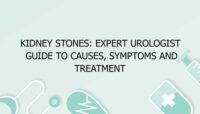Female-Specific Urologic Problems: Causes, Symptoms, and Treatment
Female-specific urologic problems encompass a range of conditions affecting the urinary system and reproductive organs. These issues can significantly impact a woman’s quality of life, requiring awareness, accurate diagnosis, and effective management. Understanding the causes, symptoms, and treatment options for these conditions is essential for maintaining urologic health in women.
Common Female-Specific Urologic Problems
1. Urinary Tract Infections (UTIs):
Urinary tract infections are among the most common urologic issues in women. They occur when bacteria enter the urinary tract, leading to inflammation and infection. Women are more prone to UTIs due to their shorter urethra, which allows bacteria to reach the bladder more easily.
- Causes: The most common cause of UTIs is bacterial infection, particularly by Escherichia coli (E. coli). Other factors include sexual activity, use of certain contraceptives, and urinary retention.
- Symptoms: Symptoms of UTIs include frequent and urgent urination, burning sensation during urination, cloudy or bloody urine, pelvic pain, and fever.
- Treatment: UTIs are typically treated with antibiotics. Hydration, pain relief, and avoiding irritants such as caffeine or alcohol can help manage symptoms. For recurrent infections, preventive measures like increased fluid intake and proper hygiene are recommended.
2. Urinary Incontinence:
Urinary incontinence is the involuntary leakage of urine, a condition that affects many women, particularly as they age. It can result from weakened pelvic floor muscles, hormonal changes, or other factors.
- Causes: Causes include weakened pelvic floor muscles, childbirth, hormonal changes, obesity, and certain medications. Stress incontinence is linked to physical activities that increase abdominal pressure, while urge incontinence is associated with an overactive bladder.
- Symptoms: Symptoms vary but generally include involuntary leakage of urine during activities such as coughing, sneezing, laughing, or exercising (stress incontinence) and a sudden, intense urge to urinate with or without leakage (urge incontinence).
- Treatment: Treatment options include pelvic floor exercises (Kegel exercises), lifestyle changes, medications, and behavioral therapies. For severe cases, surgical options such as sling procedures or bladder augmentation may be considered.
3. Interstitial Cystitis (IC):
Interstitial cystitis, also known as painful bladder syndrome, is a chronic condition characterized by bladder pain and frequent, urgent urination without a clear infection or other identifiable cause.
- Causes: The exact cause of IC is unknown, but it may involve bladder inflammation, autoimmune reactions, or nerve sensitivity. It is not caused by a bacterial infection.
- Symptoms: Symptoms include pelvic pain, frequent urination, urgency, discomfort or pain during bladder filling, and relief of symptoms after urination.
- Treatment: Treatment focuses on relieving symptoms and may include dietary modifications, bladder instillations, oral medications (such as antihistamines or tricyclic antidepressants), physical therapy, and in some cases, surgery.
4. Pelvic Floor Disorders:
Pelvic floor disorders involve the weakening or dysfunction of the muscles and tissues supporting the pelvic organs. This can lead to various problems, including pelvic organ prolapse and urinary issues.
- Causes: Causes include childbirth, aging, obesity, chronic coughing, and heavy lifting. These factors can weaken the pelvic floor muscles and connective tissues.
- Symptoms: Symptoms may include a sensation of pressure or fullness in the pelvic area, urinary incontinence, fecal incontinence, and discomfort during sexual activity.
- Treatment: Treatment options include pelvic floor exercises, physical therapy, lifestyle modifications, and surgical interventions such as pelvic organ prolapse repair or bladder suspension procedures.
5. Overactive Bladder (OAB):
Overactive bladder is a condition characterized by a frequent and urgent need to urinate, often accompanied by urge incontinence. It affects a significant number of women and can disrupt daily activities.
- Causes: The exact cause of OAB is unclear but may involve bladder muscle overactivity, nerve signaling issues, or other underlying conditions. It is often related to aging and can be associated with other urologic or medical conditions.
- Symptoms: Symptoms include frequent urination, urgency, and urge incontinence (leakage that occurs before reaching the bathroom). Some women may also experience nocturia (waking up at night to urinate).
- Treatment: Treatment includes behavioral therapies (such as bladder training and fluid management), medications (anticholinergics or beta-3 agonists), and lifestyle changes. In some cases, more advanced treatments like neuromodulation or Botox injections may be considered.
6. Vaginal Atrophy (Atrophic Vaginitis):
Vaginal atrophy refers to the thinning and inflammation of the vaginal walls due to decreased estrogen levels, often occurring after menopause.
- Causes: The primary cause is the reduction in estrogen levels associated with menopause. Other factors include childbirth, breastfeeding, and certain medical treatments.
- Symptoms: Symptoms include vaginal dryness, itching, discomfort during intercourse, and increased susceptibility to infections.
- Treatment: Treatment options include estrogen therapy (topical or systemic), lubricants, moisturizers, and lifestyle modifications. Vaginal estrogen therapy is effective in relieving symptoms and improving vaginal health.
7. Urethral Stricture Disease:
Urethral stricture disease involves the narrowing of the urethra, which can obstruct urine flow. This condition is less common in women but can occur.
- Causes: Causes include trauma, infection, or surgical procedures that lead to scarring and narrowing of the urethra.
- Symptoms: Symptoms include difficulty urinating, urinary frequency, urgency, and pain during urination.
- Treatment: Treatment may involve dilation procedures, urethral stenting, or surgical interventions to remove the stricture and restore normal urethral function.
8. Kidney Stones:
Kidney stones are solid mineral and salt deposits that form in the kidneys and can cause significant discomfort and complications.
- Causes: Causes include dehydration, high dietary intake of certain substances (such as calcium, oxalate, or uric acid), and genetic predisposition.
- Symptoms: Symptoms include severe pain in the back or side, hematuria, frequent urination, and nausea or vomiting.
- Treatment: Treatment options include increased fluid intake, pain management, medications to help pass stones, and in some cases, procedures such as shock wave lithotripsy or ureteroscopy to remove or break up the stones.
9. Urinary Retention:
Urinary retention is the inability to fully empty the bladder, which can result in discomfort and complications.
- Causes: Causes include bladder outlet obstruction, neurogenic bladder, medications, or anatomical abnormalities.
- Symptoms: Symptoms include difficulty starting urination, weak urine stream, and a feeling of incomplete bladder emptying.
- Treatment: Treatment depends on the underlying cause and may involve catheterization to relieve immediate retention, medications, and addressing the underlying issue through surgery or other interventions.
10. Bladder Cancer:
Bladder cancer involves malignant growth in the bladder lining and is a serious condition requiring prompt diagnosis and treatment.
- Causes: Risk factors include smoking, exposure to certain chemicals, chronic bladder inflammation, and genetic factors.
- Symptoms: Symptoms include hematuria, frequent urination, urgency, and lower abdominal pain.
- Treatment: Treatment options include surgery (TURBT, partial or radical cystectomy), chemotherapy, radiation therapy, immunotherapy, and targeted therapy.
Frequently Asked Questions
1. What are the common female-specific urologic problems?
Common female-specific urologic problems include urinary tract infections (UTIs), urinary incontinence, interstitial cystitis, pelvic floor disorders, overactive bladder (OAB), vaginal atrophy, urethral stricture disease, kidney stones, urinary retention, and bladder cancer.
2. What causes urinary tract infections in women?
UTIs in women are commonly caused by bacterial infections, particularly by Escherichia coli (E. coli). Risk factors include sexual activity, use of certain contraceptives, and urinary retention.
3. How is urinary incontinence treated?
Urinary incontinence is treated with a combination of pelvic floor exercises, lifestyle changes, medications, and behavioral therapies. Surgical options may be considered for severe cases.
4. What is interstitial cystitis and how is it managed?
Interstitial cystitis is a chronic condition characterized by bladder pain and frequent urination without a clear infection. Management involves dietary changes, bladder instillations, medications, and physical therapy.
5. What are pelvic floor disorders and their treatment options?
Pelvic floor disorders involve weakened or dysfunctional pelvic muscles. Treatment options include pelvic floor exercises, physical therapy, lifestyle modifications, and surgical interventions for severe cases.
6. How is overactive bladder (OAB) diagnosed and treated?
OAB is diagnosed through symptom assessment and tests to rule out other conditions. Treatment includes behavioral therapies, medications, and lifestyle changes. Advanced treatments may include neuromodulation or Botox injections.
7. What is vaginal atrophy and how is it treated?
Vaginal atrophy is the thinning and inflammation of the vaginal walls due to decreased estrogen levels. Treatment includes estrogen therapy, lubricants, and moisturizers to relieve symptoms.
8. What are the symptoms of kidney stones and how are they treated?
Symptoms of kidney stones include severe back or side pain, hematuria, frequent urination, and nausea. Treatment involves increasing fluid intake, pain management, medications, and procedures to remove or break up stones.
**9
. How is urinary retention managed?**
Urinary retention is managed based on its cause and may involve catheterization, medications, and addressing underlying issues through surgical or other interventions.
10. What are the treatment options for bladder cancer?
Treatment options for bladder cancer include surgery, chemotherapy, radiation therapy, immunotherapy, and targeted therapy, depending on the cancer stage and type.


